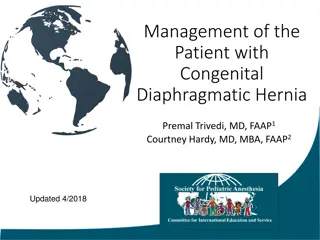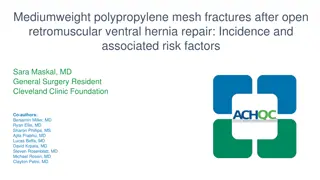Surgical Management of Hiatal Hernia
The history, advancements, and surgical options for durable hiatal hernia repair. Learn about the signs of symptomatic hiatal hernia and how modern repair techniques differ from prior surgical repairs.
Download Presentation

Please find below an Image/Link to download the presentation.
The content on the website is provided AS IS for your information and personal use only. It may not be sold, licensed, or shared on other websites without obtaining consent from the author.If you encounter any issues during the download, it is possible that the publisher has removed the file from their server.
You are allowed to download the files provided on this website for personal or commercial use, subject to the condition that they are used lawfully. All files are the property of their respective owners.
The content on the website is provided AS IS for your information and personal use only. It may not be sold, licensed, or shared on other websites without obtaining consent from the author.
E N D
Presentation Transcript
SURGICAL MANAGEMENT OF HIATAL HERNIA: A HISTORY AND BEN GERBER MD FACS 5/6/2023 RECENT ADVANCEMENTS Accreditation: Boone Medical Center is accredited by the Missouri State Medical Association to provide continuing medical education for physicians. Credit: Boone Medical Center designates this live activity for a maximum of 1 AMA PRA Category 1 Credit(s). Physicians should claim only the credit commensurate with the extent of their participation in the activity.
Disclosures Faculty Disclosures: Dr. Ben Gerber has disclosed he has no financial interest or other relationship with the manufacture(s) of the product(s) or any of the services he intends to discuss. There is no conflict of interest. Planners (Patrick Finney, Kyndal Riffie & Jarod Lafrenz) Disclosures: All event planners have disclosed that none have any financial interest or other relationship with the manufacture(s) of the product(s) or any of the services to be discussed. There is no conflict of interest. There is no commercial financial support for this live event
Learning Objectives Clinicians will learn: Options for more durable hiatal hernia repair surgery. Signs of symptomatic hiatal hernia to refer to surgery. The history of prior surgical repairs and how modern repair is different.
Intro Example case Hiatal Hernia History
Example: Mrs. CH 50 y/o F with yyy years of GERD, managed with PPI and dietary and lifestyle modifications Symptoms have been gradually worsening in severity, now poorly controlled on PPI. Prior EGD, and more recent EGD demonstrate hiatal hernia increasing in size. Now also with worsening control of her COPD
Work Up She already had an EGD, review those pictures and biopsies if done. If there is a CT or Esophagram available, also review those. She needs esophageal Manometry.
Day of Surgery Robotic Repair of Paraesophageal (Hiatal) Hernia with Mesh and LINX
Diaphragm Hernias Hiatal Hernia is the most common diaphragm hernia
First Description of Paraesophageal Hernia Dr. Henry Bowditch reviewed all 88 published reports of diaphragmatic hernia 1610-1846 All were postmortem Three cases noted what would be called a type 2 paraesophageal hernia.
The Hiatal Hernia Diagnosis Difficult to diagnose a hiatal hernia by exam. Contrast xray technology made it possible. Using combined auscultation, and xray confirmation the first diagnosis of a hiatal hernia on a live patient was conducted in 1904 by Dr Eppinger Modern Physicians diagnose hiatal hernia most often by EGD or CT and rarely on CXR.
Early Surgical Repairs Performed by : Angelo Soresi in 1919 has the first published description of elective surgery on the hiatus. Harrington at the Mayo Clinic published in 1928 a series of 27 pts. All early repair methods focused on recreating normal human anatomy with reduction of the GE junction into a natural position.
Hiatal Hernia and GERD Relationship Barrett hypothesized that the shape of the G-E junction included a dome of the cardia above the G-E junction that was important to a flap valve function. Manometry was developed in 1956 and identified the LES Esophageal pH testing wasn t developed till the 70 s
GERD and/or Hiatal Hernia What s the roll of surgery for GERD? GERD Hiatal Hernia
The advent of the Fundoplication 1956 Gastroplication by Nissen
Surgery for Hiatal hernia Many sources/opinions to reference In general most guidelines agree to consider surgery for symptomatic hiatal hernia Inadequate control of symptoms on PPI Medication side effect or compliance problems Additional medical problems caused by GERD o Barrett s, Peptic Strictures, respiratory problems (aspiration) o Gastric Volvulus, Extra-esophageal symptoms, lung compression GERD patients who are well controlled on PPI but have a hernia and are expected to live more than 5 years. https://www.ncbi.nlm.nih.gov/pmc/articles/PMC3629902/
Surgery better than PPI? Several randomized trials have been conducted Minimal surgical risks are noted Relief from PPI is variable from 90% to 40% off PPI at the conclusion of the studies 1-10 years. https://www.ncbi.nlm.nih.gov/pmc/articles/PMC2603580/ https://www.ncbi.nlm.nih.gov/pmc/articles/PMC3629902/
LINX as an option for GERD GERD control is equivalent to fundoplication Belching/Vomiting ability is preserved in >90% of patients (improved over fundoplications) Insurance coverage can be a limitation https://www.ncbi.nlm.nih.gov/pmc/articles/PMC7000944/
GERD and/or Hiatal Hernia What s the roll of surgery for Hiatal hernia? GERD Probable Surgical Benefit Hiatal Hernia
The Dark Side of Hiatal Hernia Repair Recurrence is high for traditional repairs Depending on your reference of choice recurrence after typical hiatal hernia repair with fundoplication at 5 years is 10-50%. Many treatments effective for patients with GERD and no hiatal hernia have poor long term efficacy for patient with hiatal hernia.
Divert into the history of the Inguinal Hernia Is surgical history repeating? Bassini - 1887
Variations of the inguinal hernia repair Author Year Technique reconstructing the anatomy of the inguinal canal Edoardo Bassini 1887 subcutaneous position of the spermatic cord William Steward Halsted 1889 subcutaneous position of the spermatic cord and closure of external inguinal ring Paolo Postempski 1890 herniary sac left in situ , the neck of the sac used to close internal ring 1916 Zdzis aw S awi ski Cooper s ligament instead of inguinal (Poupart s) ligament for the reconstruction Chester McVay 1942 incision and reconstruction of the transverse fascia Edward Earl Shouldice 1953
Inguinal Hernia Recurrence In 1983 Rand published that any non-mesh inguinal hernia repair had a 10% recurrence rate. When recurrence or complication rates are high (ie poor surgical quality), then people only choose to have surgery when they are desperate. If people have to be desperate before considering surgery, they present with advanced disease and complication rates are higher. The downward spiral of poor quality service and human suffering.
Evils of Tension Most surgeons at the time believed the failures were due to tension on the repair.
The Tension Free Inguinal Hernia Repair Published in 1989 with low recurrences Follow up published in 1995 with 4000 pts showing 4 recurrences
The Laparoscopic Inguinal Hernia Repair Rives-Stoppa initially described a pre-peritoneal hernia repair with mesh using an open technique for giant and recurrent inguinal hernias in the 1966, performed for the first time in 1973. Laparoscopic modification of the method is now standard
Why Lichtenstein and Reve-Stoppa? Their techniques are reproducible The methods don t require extreme surgical risks or extraordinary talent to complete The methods provide for outpatient, low risk procedures with excellent risk profile for complication or recurrence.
When should a hernia be repaired? The Watchful Waiting VA study Randomized 720 men with asymptomatic inguinal hernia to surgery or waiting. Published in 2006 2-4 years F/U Showed 23% of patients crossed over to surgery due to increased pain After 11 years of follow up, 68% of patients crossed over to surgery usually for symptoms of pain Low risk of bowel strangulation
Current State of the Art for Inguinal Hernia Inguinal hernias get slowly worse over time. The surgeries available now are outpatient, low risk, and highly effective with very low chance of hernia recurrence. Large hernias in older patients carry a higher risk of complication. Why wait a long time to get your hernia repaired
Back to Hiatal Hernia again: Traditional Hiatal Hernia Repair Traditional Open Inguinal Hernia Repair Quality
What happens to a Hiatal Hernia over time? Using retrospective data mining search methods, they found 89 pts who had Fluoro studies > 5 years apart. Only 20% of Type 1 HH were stable Only 40% of larger HH were stable https://pubmed.ncbi.nlm.nih.gov/32773629/
Quality Improvement Efforts How to reduce recurrence rates for Hiatal Hernia Repair? What has been done in the context of other hernia types to reduce recurrence rates? Mesh Relaxing Incisions
The use of Mesh Randomized controlled trials appear to demonstrate no long term benefit to use of dissolving mesh with hiatal hernia repair. Although early recurrence appears to be lower with use of absorbable mesh. Permanent mesh has been associated with erosion into the esophagus.
LINX in patients with Hiatal Hernia Two studies indicate risk of hiatal hernia recurrence is low: 6.3% at 3 years, 4.3% at 1.5 yr Risk of post op complications are similar to published fundoplication data: dysphagia (5-15%), gas bloat 30%, persistent GERD (5-13%) with 90% of patient able to retain normal burping/vomiting ability.
GERD and/or Hiatal Hernia Is LINX better than traditional surgery? Probably not GERD Hiatal Hernia Likely Yes
Probably Yes Several studies with short and long term follow up have demonstrated lower rate of hiatal hernia recurrence than similar reports on traditional hiatal hernia repair recurrence rates.
How I Use LINX LINX replaces the traditional Nissen Fundoplication component of a Hiatal Hernia Repair surgery. Only patient s with normal swallow function can tolerate a LINX device (because I cannot adjust the magnetic attractions)
Additional Research is Needed: 1. A randomized trial for patients with hiatal hernia undergoing traditional surgery or LINX based repairs needs to be conducted. Most Insurance consider LINX for GERD to be investigational. Therefore at Boone LINX is provided by the hospital in the context of a paraesophageal hernia repair, because the reimbursement for that paraesophageal hernia repair is able to cover the cost of LINX and still turn a small profit. 2. 3.
References Endoscopy Campus - Hiatus hernias and the Hill classification (endoscopy- campus.com) Historical aspects of the anatomy of the cardia with special reference to hiatus hernia. (nih.gov) https://www.ncbi.nlm.nih.gov/pmc/articles/PMC1806549/?page=12 The results of Hill's operation (oeso.org) FULL TEXT - A now rarely seen anti-reflux device: The Angelchik prosthesis - International Journal of Case Reports and Images (IJCRI) (ijcasereportsandimages.com) https://www.semanticscholar.org/paper/Diaphragmatic-relaxing-incisions- during-hernia-Greene- DeMeester/b57e959933f379bac648f492cbb25b86e647852b Antireflux Endoluminal Therapies: Past and Present (hindawi.com)
References Magnetic sphincter augmentation with hiatal hernia repair: long term outcomes - PubMed (nih.gov) Hiatal hernia recurrence following magnetic sphincter augmentation and posterior cruroplasty: intermediate-term outcomes - PubMed (nih.gov) Magnetic sphincter augmentation (MSA) in patients with hiatal hernia: clinical outcome and patterns of recurrence - PubMed (nih.gov) Efficacy of magnetic sphincter augmentation in patients with large hiatal hernias - PubMed (nih.gov) History of the Inguinal Hernia Repair | IntechOpen Watchful Waiting vs Repair of Inguinal Hernia in Minimally Symptomatic Men: A Randomized Clinical Trial | Surgery | JAMA | JAMA Network























